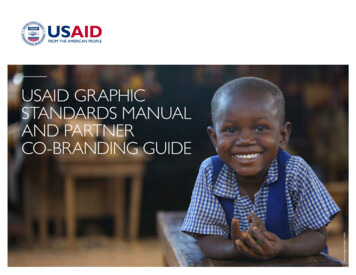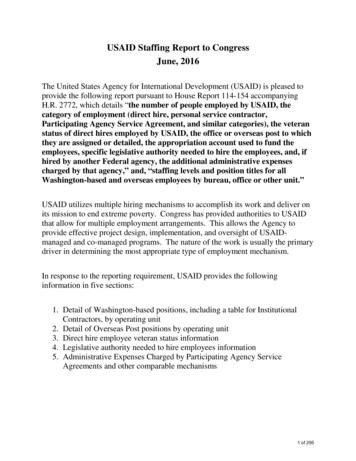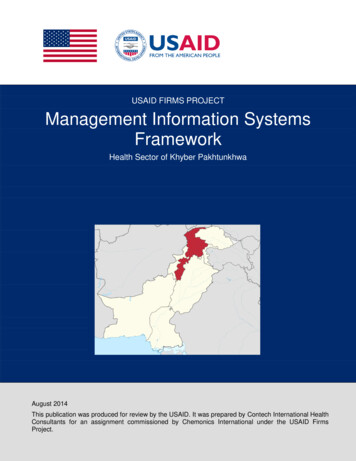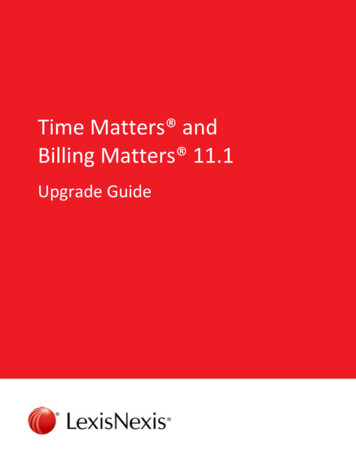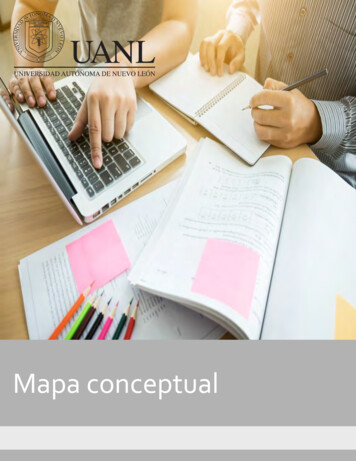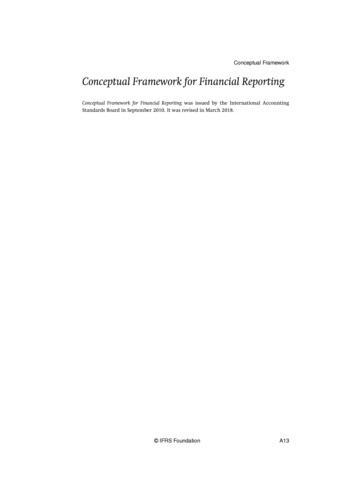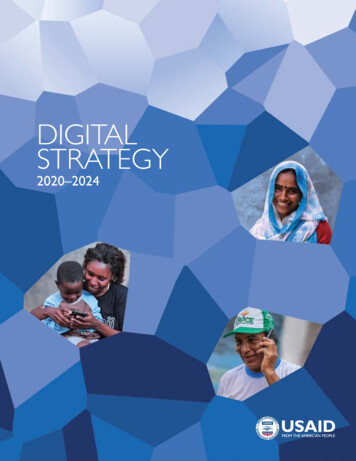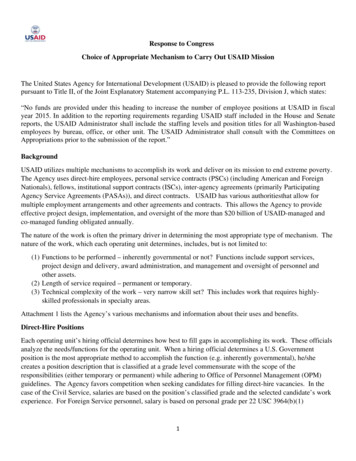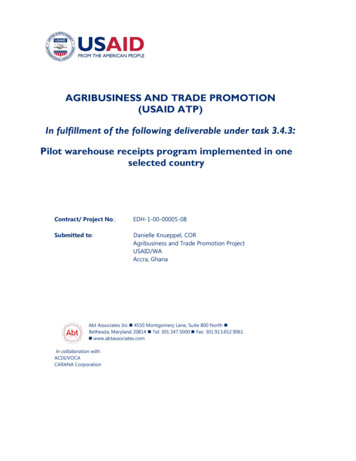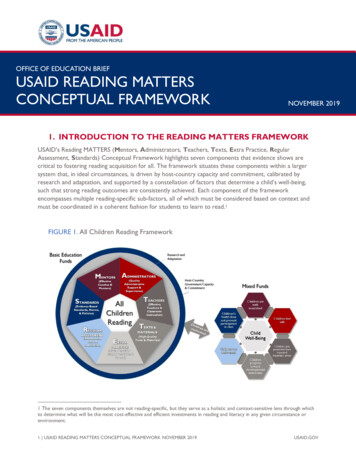
Transcription
OFFICE OF EDUCATION BRIEFUSAID READING MATTERSCONCEPTUAL FRAMEWORKNOVEMBER 20191. INTRODUCTION TO THE READING MATTERS FRAMEWORKUSAID’s Reading MATTERS (Mentors, Administrators, Teachers, Texts, Extra Practice, RegularAssessment, Standards) Conceptual Framework highlights seven components that evidence shows arecritical to fostering reading acquisition for all. The framework situates these components within a largersystem that, in ideal circumstances, is driven by host-country capacity and commitment, calibrated byresearch and adaptation, and supported by a constellation of factors that determine a child’s well-being,such that strong reading outcomes are consistently achieved. Each component of the frameworkencompasses multiple reading-specific sub-factors, all of which must be considered based on context andmust be coordinated in a coherent fashion for students to learn to read.1FIGURE 1. All Children Reading Framework1 The seven components themselves are not reading-specific, but they serve as a holistic and context-sensitive lens through whichto determine what will be the most cost-effective and efficient investments in reading and literacy in any given circumstance orenvironment.1 USAID READING MATTERS CONCEPTUAL FRAMEWORK NOVEMBER 2019USAID.GOV
This framework incorporates, and expands upon, the elements of the five Ts framework (Time, Texts,Tongue, Teaching, and Testing) that USAID used as an organizing principle for agency investments in earlygrade reading from 2011 to 2018. The dynamic relationship between the seven education-specificcomponents on the left in Figure 1 and the six facets of child well-being on the right is at the heart ofincreasing students’ motivation to learn to read. The framework sets out, for each component and subfactor, an evidence-based description of the ideal conditions that should prevail under that component orsub-factor in order to foster the most widespread progress toward literacy for those beginning to learn toread.USAID’s Reading MATTERS Framework can be used by national, regional, or local governments, or bydonor agencies and their implementing partners, to inform the planning, execution, and evaluation ofreading and literacy instructional programs for primary grade students and youth. Using the framework as astarting point, development practitioners and educators can identify the strengths, weaknesses, and gaps inreading instruction in any education system. They can conduct targeted analysis and develop contextappropriate literacy interventions that advance USAID’s education priorities in all types of learningenvironments. When possible, all elements in the Reading MATTERS framework (those that are readingspecific from the left of the diagram and those related to child well-being from the right of the diagram)should be explored before designing reading interventions, using a tool like the Literacy Landscape Analysis.However, when this is not feasible, governments, donors, and partners can simply use the framework as away of identifying potential gaps in analysis and/or reading programming, especially in cases when readinginterventions do not have the desired impact.USAID’s Reading MATTERS Framework is adaptable to the needs and available resources of an educationprogram. Analysis and interventions guided by the framework can target specific components and factors inan education system. Or, if resources are available, they can address all of the components, strengtheningthe connections between sub-factors and accelerating the pace at which all children receive the high-qualityreading instruction they deserve.2. ALL CHILDREN READING: COMPONENTS AND SUB-FACTORSThis section provides, for each of the components on the left of the framework, an overview of major subfactors that must be in harmony with one another to ensure that children learn to read. The interplaybetween these components and all of their sub-factors is critical to ensuring that children achieve the bestpossible reading outcomes. The components are evidence-based and designed to build on and reinforceeach other to inform a seamless system for delivery of high-quality reading instruction at scale. In USAIDfunded activities seeking to improve learning outcomes, basic education resources will often need tosupport improvement in at least one of the seven components. However, which components are in needof intervention or support will depend entirely on country contextual analysis.All Children ReadingThe system provides, in a safe environment, high-quality, consistent reading instruction for all, inclusive of,but not limited to, girls and boys, those living in poverty, rural and urban learners, children who arevulnerable or experiencing marginalization, those of all genders and sexual orientations, children withdisabilities, indigenous peoples, and ethnic/linguistic minorities. For the system to support all learners, allcomponents of the framework must incorporate principles of universal design for learning, and researchmust focus on differences in outcomes between groups.2 USAID READING MATTERS CONCEPTUAL FRAMEWORK NOVEMBER 2019USAID.GOV
Host Country Government Commitment and Capacity Host-country governments (or those in charge of ensuring that children learn to read in a givencontext) demonstrate commitment to high-quality reading instruction on two levels: a) at ageneral system level (for example, by allocating at least 18 percent of their budget or 4 percent oftheir GDP to education), and b) at a subject-specific level, (for example, by passing an educationlaw that supports multilingualism and stipulates that the youngest students must receive 3-6 yearsof reading instruction in a language they use and understand before “transitioning” to a less familiarlanguage). Ministries of Education, Planning, and Finance increase their capacity to teach reading bycultivating: a) a human resource base qualified to teach reading, b) a materials production cyclethat guarantees appropriate reading material for every learner, c) budgeting procedures thatstabilize the supply of teachers, materials, and testing procedures needed to support readingdevelopment, and d) research and evaluation expertise to examine and report on readinginstruction and outcomes.Research and Adaptation Key stakeholders and institutions continually collect and use data on reading outcomes, classroominstruction in reading, teacher knowledge/behavior, school environments and materials, and accessto reading materials for extra practice outside of school, including identifying differences insubpopulations. By analyzing this data, they learn what strengths and gaps exist in the ReadingMATTERS system in their context, so that they can adapt programming to assist all children tolearn to read.Standards (Evidence-Based Standards, Norms, Policies) National book policy includes a coherent set of regulations and indicators to govern thedevelopment, production, printing, distribution, dissemination, and use of reading materials. Standards for government approval and procurement of reading material include criteria to ensurethat books are affordable, appropriate, accessible, and widely available (i.e. open source). Government adopts national reading curriculum that allocates at least 90 minutes a day to readinginstruction, sequences basic skills according to the evidence base, provides for appropriateinstructional and practice time, and follows best practice for the introduction of foreign languagesinto the reading classroom. Policy establishes appropriate reading benchmarks/standards and targets as well as an assessmentframework for screening the needs of all learners by sub-population and monitoring their progress. Policy provides for appropriate incentives, certification, assignment, oversight, support, andongoing professional development both for teacher performance and attendance in general and inthe specifics of reading instruction for school leaders and teachers.3 USAID READING MATTERS CONCEPTUAL FRAMEWORK NOVEMBER 2019USAID.GOV
Texts (High-Quality Texts and Materials) Every student is issued his/her/their own essential reading materials (i.e. decodable readers, leveledreaders, supplementary reading material) designed specifically for reading instruction in languagesstudents use and understand outside of school. All books that students use meet Global Book Alliance standards for being available, accessible,appropriate, and affordable, and are printed and bound using paper and processes of high enoughquality to render them durable. Every student has access to fiction and non-fiction story books, all of which are language- andlevel-appropriate. Learners with disabilities have texts available that are born accessible (i.e. designed in its firstversion for use by those with disabilities, for example by including braille or signed translationwhen a title is published) so they can use them. Every teacher has a structured teacher’s guide that aligns with the curriculum and textbooks andmakes his/her/their job of teaching reading and literacy easier.Teachers (Effective Teachers and Classroom Instruction) Pre- and in-service training in the specifics of reading and literacy instruction are aligned with oneanother, based on teachers’ needs/skill-set, and provide classroom-based opportunities to practicenew reading instructional skills. Teachers implement evidence-based, direct, and explicit reading instruction in languages studentsunderstand and maximize time on task in reading instruction so that students spend the majorityof their class time in their own reading practice (i.e. as contrasted with listening to the teacherread). Teachers use universal design principles to the best of their ability in reading instruction, enablingdisabled learners to gain reading and literacy skills.Mentors and Coaches (Effective Coaches and Mentors) Literacy coaches are trained education professionals, with significant knowledge of reading andliteracy instruction, that effectively support and improve teachers’ reading instructional skills. Literacy coaching occurs at ongoing, regular intervals with greater intensity at the beginning of aprogram (or teacher’s career) and less intensity as teachers gain mastery of reading instructionalskills.Administrators (Quality Administrative Support and Supervision) School leader and district/regional-level education officer training and practice ensure oversightand monitoring of teacher and student attendance and instructional quality in schools, particularlywith regards to reading instruction. School administrators take steps to ensure that their schools are safe for all teachers and learners,(for example, instituting reporting structures and protocols for reporting and responding to4 USAID READING MATTERS CONCEPTUAL FRAMEWORK NOVEMBER 2019USAID.GOV
incidents of violence/abuse and/or ensuring that appropriate disaster risk reduction measures arein place).Regular Assessments (Assessments Inform Instruction) All reading assessments are leveled and aligned with curriculum and benchmarks. At the classroom level, teachers assess all learners’ reading ability both formatively (to determinelearning needs and adapt instruction) and summatively (to measure progress toward end-of-termor end-of year benchmarks). At district, regional, or national levels, representative assessments of reading ability for grades 2, 4,and 6 are conducted approximately every two years and analyzed in conjunction with regularmonitoring data on quality of instruction, access of learners and teachers to materials, and teacherknowledge, among other data sources. Anonymized aggregate data is stored and protected in thelocal Education Management Information System, widely disseminated, and used to inform readinginstruction policy and practice.Extra Practice (Extra Practice and Support Outside of School) Family and community members support expressive language development and the promotion ofdaily reading skills practice as they are able, including by listening to learners reading from an earlyage and by reading to them if they have the skills to do so. All family members can play somepositive role in supporting literacy development, and research suggests that most families includeat least one member (a sibling, an aunt, an uncle, a grandparent, a cousin, etc.) who has some basicreading skill. Appropriate, accessible, and affordable reading materials are available for children and their familiesfor reading practice outside of school. Family and community members receive support in using these materials, as necessary dependingon their own literacy levels.3. CHILD WELL-BEING: COMPONENTS AND SUB-FACTORSThis section provides, for each of the child well-being components on the right of the framework, anoverview of key sub-factors that, when present, accelerate and enhance reading acquisition. The bestreading outcomes will occur when children’s well-being, as measured according to the six well-being subfactors, is nurtured and assured.However, host country governments, donors, and other education stakeholders such as NGOs and privateactors should not wait to initiate improvements in reading delivery systems until students’ well-being isguaranteed. Rather, when possible, they should promote cross-sectoral efforts (and funding) to addresswell-being concerns at the same time as they endeavor to improve and harmonize the functioning of theseven components of strong reading delivery systems. They should also use these components and subfactors to better understand why systems that include effective implementation of the seven elements onthe left may not be yield consistently strong reading outcomes. Additionally, this framework may supportefforts to identify strategic partnerships within USAID activities and between the work of USAID, otherdonors, and host-country governments that help to advance learning.5 USAID READING MATTERS CONCEPTUAL FRAMEWORK NOVEMBER 2019USAID.GOV
Child Well-Being Children are healthy, well-nourished, safe, and protected from repeated traumatic stress in theschool, community, and home environments. They are progressing toward cognitive andcommunications developmental milestones, and they arrive at school well-nourished and wellrested.Children’s Health Does Not Prevent Participation in Class All students have the a) vaccinations, b) medications, and c) primary care they need to stay well,recover quickly from illness, and attend reading class regularly in order to optimize their readingoutcomes. Children of lower socio-economic status and/or those who experience frequent illness receivetargeted outreach and support to ensure they are healthy enough to attend reading class withtheir peers.Children Are Well-Nourished Learners are food and nutrition secure, meaning food and nutrients are available through home,school, or elsewhere; they are able to access and use them; and their sources are stable, asrequired under the Global Strategic Framework for Food Security and Nutrition. Learners are well-nourished during early childhood and throughout their years of schooling,enabling them to develop cognitively and physically to be prepared to learn.Children Feel Safe Learners feel and are safe getting to and from school. Children are free from physical, sexual, and psychological violence/abuse, including bullying, whileat school, thereby increasing their likelihood of being able to learn.Children Are Protected from Repeated Traumatic Stress Children are free from repeated traumatic physical, emotional, and environmental stress and/orare receiving support to manage and cope with stress. Children develop a healthy stress response system, allowing them to progress in their educationdespite adversity.Children Progress Toward Developmental Milestones Children’s motor, communication, and cognitive skills development proceeds as expected;progress can be charted on an internationally recognized scale for child growth and developmentand provides the needed linguistic and metacognitive basis for learning to read. Children with learning disabilities experiencing language-based problems with reading, spelling, andwriting receive evidence-based, specific, and targeted in- and out-of-school instruction and supportin order to learn to read.6 USAID READING MATTERS CONCEPTUAL FRAMEWORK NOVEMBER 2019USAID.GOV
Children Are Well-Rested Children benefit from both a quality and quantity of sleep that enables them to both learn andremember, functions that are critical for reading acquisition. Learners get at least nine hours of quality sleep each night before participating in reading class.4. REFERENCESAustralian Government Department of Education, Science and Training. 2005. Teaching Reading: NationalInquiry into the Teaching of Literacy. Commonwealth of Australia. Accessed July 30, 2019.https://www.academia.edu/7799827/National Inquiry into the Teaching of Literacy Report and Recommendations 7317SCHP05A Teaching Reading Report and Recommendations Teaching ReadingAmerican Speech-Language-Hearing Association. 2019. Learning Disabilities. Accessed September 3, LBLD.htmBundy, D. A. P., N. de Silva, S. Horton, D. T. Jamison, and G. C. Patton. 2018. Optimizing EducationOutcomes: High-Return Investments in School Health for Increased Participation and Learning. Washington, DC:World Bank. License: Creative Commons Attribution CC BY 3.0 IGO.Committee on World Food Security (CFS), Global Strategic Framework for Food Security and es/cfs/Docs1011/WG GSF/GSF annotated outline formatted Rev122 Jun 11.pdfEducation in Crisis and Conflict Network (ECCN). 2018. Rapid Education Risk Analysis Toolkit. Washington,DC: United States Agency for International Development. Accessed at -and-risk-analysis-rera-toolkit-0Ehrich, et. al. 2010. “Attendance, performance, and the acquisition of early literacy skills: A comparison ofindigenous and non-indigenous school children.” Australian Journal of Learning Difficulties, Volume 15, Issue 2,pages 131-149. Accessed September 3, 2019. 524580Frank, Hillary A. 2014. “Toxic Stress: Effects, Prevention, and Treatment.” Children (Basel, Switzerland), 1(3),390–402. doi:10.3390/children1030390.Gelli, Aulo. 2015. School Feeding in Low-Income Settings: A Snapshot of the Evidence. “Feed and Read: ImprovingAccess to School Meals and Quality Education Around the World” USDA McGovern-Dole and USAIDPanel at the 2015 USAID Global Education Summit November 2, 2015, Silver Spring, MD. Accessed documents/1865/Presentation3.pdfCenter on the Developing Child at Harvard University. “Toxic Stress.” DevelopingChild.Harvard.edu.Accessed September 3, 2019. ncepts/toxic-stress/Hayes, Anne, Norma Moran, and Ann Turnbull. 2018. Universal Design for Learning to Help All Children Read:Promoting Literacy for Learners with Disabilities (First Edition). A Global Reading Network Resource. Preparedby University Research Co., LLC. (URC) under the Reading within REACH initiative for USAID’s Building7 USAID READING MATTERS CONCEPTUAL FRAMEWORK NOVEMBER 2019USAID.GOV
Evidence and Supporting Innovation to Improve Primary Grade Assistance for the Office of Education(E3/ED).Harvard Medical School, Division of Sleep Medicine. 2008. Sleep, Learning, and Memory. Healthy SleepWebsite. Accessed September 3, 2019. s/benefits-ofsleep/learning-memoryKim, Young-Suk Grace, Helen N. Boyle, Stephanie Simmons Zuilkowski, and Pooja Nakamura. 2017. TheLandscape Report on Early Grade Reading Skills. A Global Reading Network Resource. Prepared by UniversityResearch Co., LLC. (URC) under the Reading within REACH initiative for USAID’s Building Evidence andSupporting Innovation to Improve Primary Grade Assistance for USAID.Kim, Young-Suk Grace and Marcia Davidson. 2019. Assessment to Inform Instruction: Formative Assessment.Global Reading Network Critical Topics Series. Prepared by University Research Co., LLC. (URC) underthe Reading within REACH initiative for USAID’s Building Evidence and Supporting Innovation to ImprovePrimary Grade Assistance for USAID.Kim, Young-Suk Grace, and Marcia Davidson. 2019. Promoting Successful Literacy Acquisition ThroughStructured Pedagogy. Global Reading Network Critical Topics Series. Prepared by University Research Co.,LLC. (URC) under the Reading within REACH initiative for USAID’s Building Evidence and SupportingInnovation to Improve Primary Grade Assistance for USAID.Pflepsen, Alison. 2019. Coaching in early grade reading programs: Evidence, experiences and recommendations.Global Reading Network Critical Topics Series. Prepared by University Research Co., LLC. (URC) underthe Reading within REACH initiative for USAID’s Building Evidence and Supporting Innovation to ImprovePrimary Grade Assistance for USAID.Piper, Ben, Stephanie Simmons Zuilkowski, Margaret Dubeck, Evelyn Jepkemei, and Simon J. King. 2018.“Identifying the Essential Ingredients to Literacy and Numeracy Improvement: Teacher ProfessionalDevelopment and Coaching, Student Textbooks, and Structured Teachers’ Guides.” World Development 106(June): 324-336. nski, Patrick. 2010. Providing books for schools and libraries in Africa: What is the impact on literacy? AccessedJuly 30, d, Tony. 2015. Where Have All The Textbooks Gone? Toward sustainable provision of teaching andlearning materials in Sub-Saharan Africa. Directions in Development. Washington, DC: World Bank.doi:10.1596/978-1-4648-0572-1.Reach Out and Read, Inc. 2013. Milestones of Early Literacy Development. Accessed September 3, /RORmilestones English.pdfResults for Development and International Education Partners (R4D), April 2016. Global Feasibility Study,Final Report.RTI International. 2013. Literature Review on the Intersection of Safe Learning Environments andEducational Achievement. Washington, DC: U.S. Agency for International Development.8 USAID READING MATTERS CONCEPTUAL FRAMEWORK NOVEMBER 2019USAID.GOV
Sorhaindo, Annik and Leon Feinstein. 2006. What is the Relationship Between Child Nutrition and SchoolOutcomes? Wider Benefits of Learning Research Report No. 18. Accessed af65fae3d321c8b059ab7208a4.pdfTaras, Howard, and William Potts‐Datema. 2005. “Sleep and student performance at school.” Journal ofSchool Health 75, no. 7: 248-254.USAID. 2018. “Reading Programs that Work: Elements of Success.” Accessed July 30, ograms-work.World Bank. 2018. World Development Report 2018: Learning to Realize Education's Promise. Washington,D.C.: World Bank.9 USAID READING MATTERS CONCEPTUAL FRAMEWORK NOVEMBER 2019USAID.GOV
2 USAID READING MATTERS CONCEPTUAL FRAMEWORK NOVEMBER 2019 USAID.GOV This framework incorporates, and expands upon, the elements of the five Ts framework (Time, Texts, Tongue, Teaching, and Testing) that USAID used as an organizing principle for agency investments in early grade reading from 2011 to 2018.
